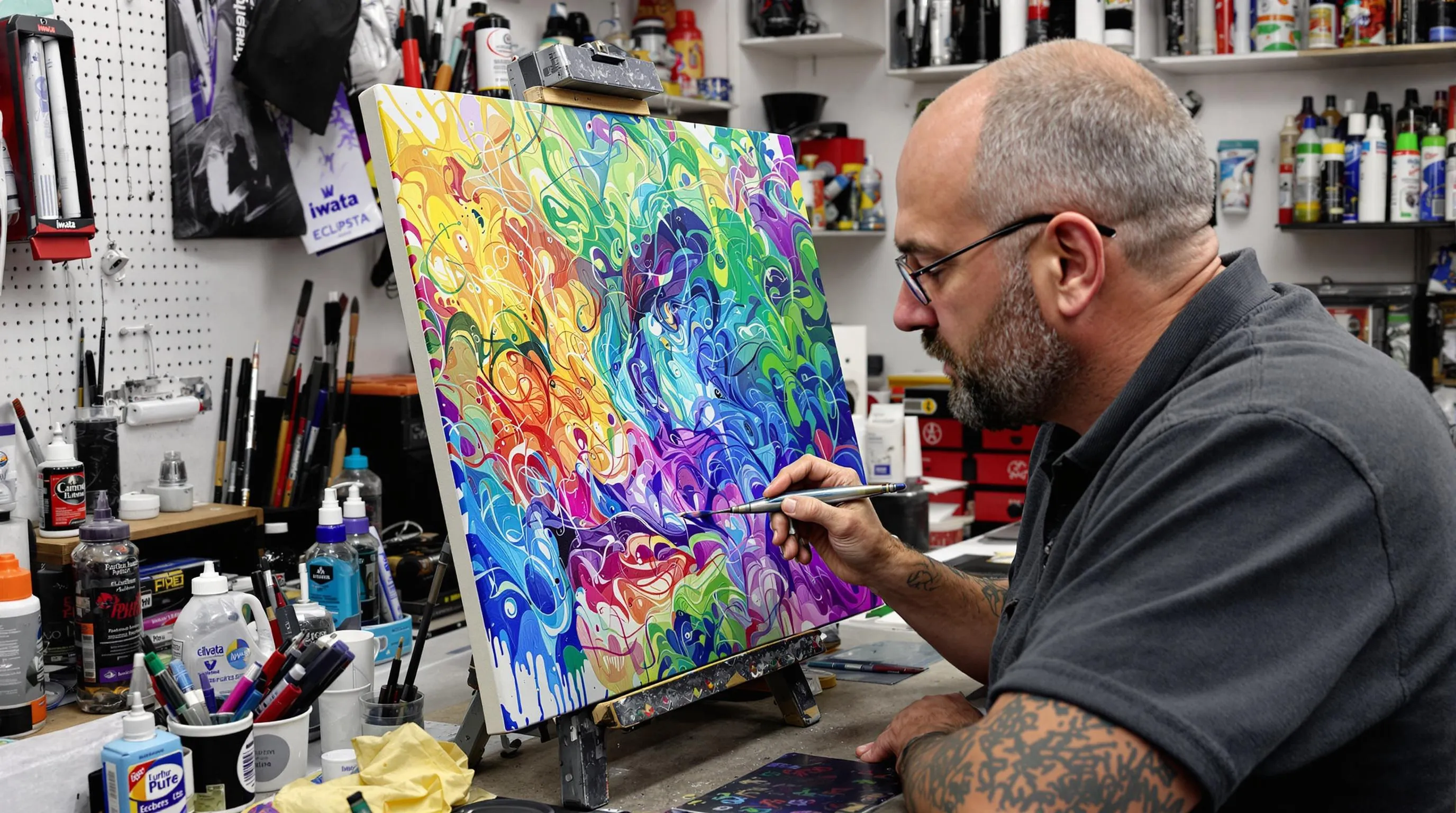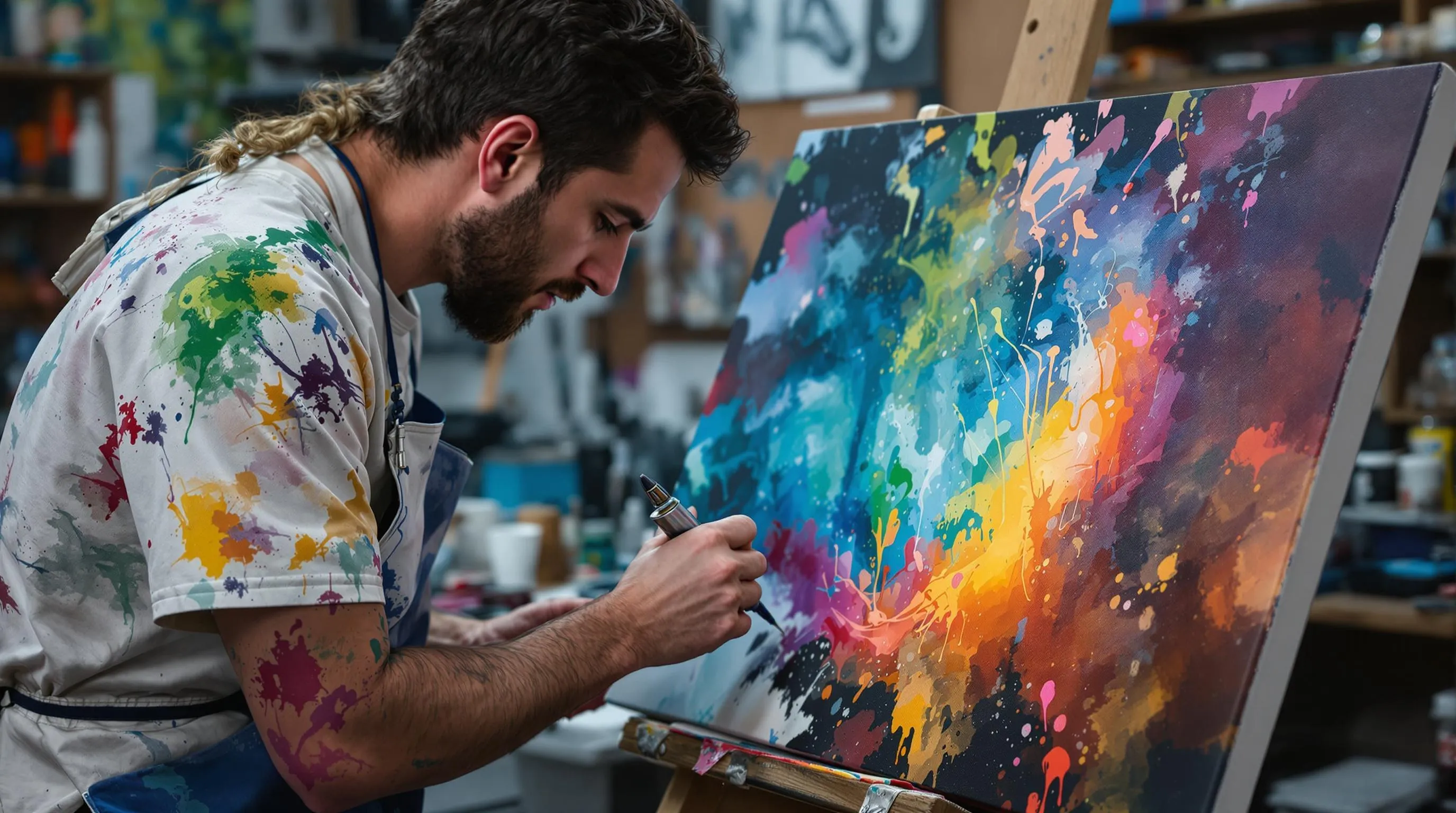Finding the perfect airbrush for acrylic paint can transform your artistic journey from frustrating to absolutely magical. Whether you’re a seasoned professional or just starting your airbrushing adventure, we understand how overwhelming it can be to navigate through countless options and technical specifications.
We’ve spent hundreds of hours testing airbrushes with various acrylic formulations to bring you the most comprehensive guide available. From delicate detail work on miniatures to bold murals and everything in between, the right airbrush makes all the difference in achieving those smooth, professional-looking finishes you’ve been dreaming about.
Our carefully curated selection considers factors like paint flow control, ease of cleaning, durability, and value for money. We’ll help you cut through the marketing hype and find an airbrush that truly matches your exact needs and budget, so you can focus on what matters most – creating stunning artwork.
Understanding Airbrush Types for Acrylic Paint Applications
Choosing the right airbrush type directly impacts your acrylic painting results and overall experience. Each design offers exact advantages that cater to different painting styles and skill levels.
Single-Action vs. Dual-Action Airbrushes
Single-action airbrushes control paint flow through a preset mechanism that releases a fixed amount of paint when you press the trigger. These models work best for beginners since they eliminate the complexity of coordinating multiple controls simultaneously. Coverage applications like base coats and backgrounds become effortless with single-action designs.
Dual-action airbrushes provide independent control over both air and paint flow through trigger manipulation. Pressing down releases air while pulling back increases paint flow, giving you precise control over line width and paint density. Detail work benefits significantly from this enhanced control, making dual-action models essential for professional illustration and fine art applications.
Gravity Feed vs. Siphon Feed Systems
Gravity feed airbrushes position the paint cup on top of the airbrush body, allowing paint to flow downward naturally into the mixing chamber. This design requires less air pressure to operate effectively and provides better paint atomization for smooth finishes. Detail work becomes more manageable since gravity feed systems work efficiently with small paint quantities.
Siphon feed airbrushes draw paint upward from a bottom-mounted container through suction created by airflow. These systems excel at covering large areas since they accommodate bigger paint reservoirs and maintain consistent flow during extended painting sessions. Production work and mural applications benefit from the increased paint capacity that siphon feed designs provide.
Internal Mix vs. External Mix Designs
Internal mix airbrushes combine air and paint inside the airbrush body before releasing the mixture through the nozzle. This design creates finer atomization and smoother paint application, making it ideal for detailed work and professional finishes. Color blending becomes more seamless with internal mix systems since they produce consistent spray patterns.
External mix airbrushes combine air and paint outside the nozzle tip, creating a coarser spray pattern suitable for textural effects and coverage work. These designs handle thicker paint consistencies more effectively and require less maintenance since paint doesn’t travel through internal passages. Hobby applications and create projects often benefit from the simplicity and versatility of external mix airbrushes.
Key Features to Consider When Choosing an Airbrush for Acrylics

Selecting the right airbrush for acrylic paint involves evaluating several critical features that directly impact your painting results. We’ve identified the most important characteristics that’ll determine how well your airbrush performs with acrylics.
Needle and Nozzle Size Compatibility
Needle and nozzle compatibility plays a crucial role in preventing clogs when working with acrylic paints. Thicker paint requires larger nozzle sizes to maintain smooth flow and avoid frustrating blockages during your painting sessions. We recommend choosing airbrushes with needle and nozzle combinations specifically designed for the viscosity of acrylic paint you’ll be using.
Compatibility between these components ensures consistent paint delivery throughout your project. Standard nozzle sizes range from 0.2mm for fine detail work to 0.5mm for broader coverage, allowing you to match your equipment to your exact painting requirements. Different acrylic paint formulations may need different nozzle sizes, so consider the variety of paints you plan to use.
Paint Cup Capacity and Design
Paint cup capacity directly affects how long you can paint without interruption during extended sessions. Larger cups reduce refill frequency, which becomes particularly important when working on substantial projects or applying base coats. We find that cups ranging from 2ml to 9ml cover most acrylic painting needs effectively.
Design elements of the paint cup significantly impact your overall painting experience. Easy filling and cleaning capabilities should be prioritized when evaluating different airbrush models. Cup positioning and accessibility determine how quickly you can refill paint and how thoroughly you can clean between color changes.
Trigger Sensitivity and Control
Trigger sensitivity enables precise control over paint flow, which becomes essential for detailed acrylic work. Sensitive triggers allow better regulation of both air and paint flow, giving you the control needed for fine lines, gradations, and precise color placement. We’ve found that responsive triggers make the difference between amateur and professional looking results.
Control mechanisms vary significantly between airbrush models and directly affect your painting precision. Dual action triggers provide independent control of air and paint flow, allowing for more sophisticated techniques with acrylic paints. Progressive trigger response helps you achieve smooth transitions and consistent coverage across your artwork.
Easy Cleaning and Maintenance Features
Cleaning efficiency becomes paramount when working with acrylic paints that can dry quickly and permanently damage your equipment. Disassembly design should prioritize simplicity, allowing you to quickly access all paint contact surfaces for thorough cleaning. We recommend airbrushes with minimal small parts that could be easily lost during maintenance.
Maintenance features directly impact the longevity and performance of your airbrush with acrylic applications. Quick release mechanisms and accessible internal components reduce cleaning time and ensure you can properly maintain your equipment. Regular cleaning becomes much more manageable when your airbrush design supports efficient maintenance routines.
Top Professional Airbrushes for Acrylic Paint Projects

We’ve identified three exceptional professional airbrushes that consistently deliver outstanding results with acrylic paints. These models represent the pinnacle of airbrush technology, offering the precision and reliability that serious artists demand.
Iwata Eclipse HP-CS
Outstanding precision defines the Iwata Eclipse HP-CS, making it our top choice for artists who demand exceptional detail work. This gravity fed, dual action airbrush features a 0.35 mm nozzle that handles fine to medium detail applications with remarkable consistency. We appreciate how this nozzle size works perfectly with properly thinned acrylics, delivering smooth paint flow without clogging issues.
Individual quality assurance testing by Iwata ensures each airbrush meets their exacting standards before reaching your hands. The Eclipse HP-CS excels at both intricate miniature painting and broader coverage applications, making it incredibly versatile for various acrylic paint projects. Cleaning and maintenance couldn’t be easier, thanks to the thoughtful engineering that allows quick disassembly and thorough cleaning between color changes.
Durability stands as a hallmark of this professional grade airbrush, with users reporting years of reliable performance under demanding conditions. Model painters and hobbyists consistently choose the Eclipse HP-CS for its ability to produce consistent spray patterns and maintain precision over extended painting sessions.
Badger Air-Brush Patriot 105
Versatility drives the design of the Badger Air-Brush Patriot 105, offering both beginners and advanced users exceptional performance with acrylic paints. This bottom feed, dual action airbrush accommodates various nozzle configurations between 0.2 mm and 0.5 mm, allowing artists to switch from fine detail work to larger area coverage seamlessly.
Robust metal construction ensures this airbrush withstands the demands of frequent use and color changes. We’ve found the Patriot 105 particularly effective for artists who need consistent spray performance across different acrylic paint viscosities. The easy disassembly feature makes cleaning between colors quick and efficient, reducing downtime during creative sessions.
Known for consistent spray quality, this airbrush delivers reliable results whether you’re working on detailed illustrations or covering broader surfaces. Long painting sessions become more enjoyable with the Patriot 105’s comfortable ergonomics and dependable performance characteristics.
Harder & Steenbeck Evolution Silverline
Quick change nozzle systems set the Harder & Steenbeck Evolution Silverline apart from conventional airbrushes. This professional model includes both 0.2 mm and 0.4 mm interchangeable nozzles, enabling artists to switch between fine detail work and larger coverage applications without changing airbrushes entirely.
Ergonomic handle design provides comfortable control during extended painting sessions, while the precise airflow and paint flow controls allow for exceptional accuracy. We’ve observed excellent compatibility with acrylic paints, with minimal clogging issues even when working with various paint consistencies. The ability to create both fine lines and broad sprays makes this airbrush ideal for complex projects requiring multiple techniques.
High quality construction reflects the professional grade engineering that makes this airbrush suitable for demanding commercial and artistic applications. Easy maintenance procedures ensure the Evolution Silverline continues performing at peak levels, making it a worthwhile investment for serious acrylic paint artists.
| Feature | Iwata Eclipse HP-CS | Badger Patriot 105 | Harder & Steenbeck Evolution |
|---|---|---|---|
| Feed Type | Gravity | Bottom/Siphon | Gravity |
| Action Type | Dual Action | Dual Action | Dual Action |
| Nozzle Size | 0.35 mm | 0.2-0.5 mm options | 0.2 mm & 0.4 mm included |
| Best For | Precision detail work | Versatile applications | Professional flexibility |
| Maintenance | Easy cleaning | Simple disassembly | Quick nozzle changes |
Best Budget-Friendly Airbrushes for Acrylic Paint Beginners

After testing many affordable options, we’ve identified three standout airbrushes that deliver professional results without very costly. These models excel with acrylic paints while offering the user-friendly features beginners need to develop their skills.
Master Airbrush Multi-Purpose Gravity Feed
Master Airbrush designed this gravity feed model specifically for versatility with acrylic paints. We found its gravity feed system allows for efficient paint usage and remarkably easy cleaning between color changes. Control over both base coating and fine detail work impressed us during testing. Beginners consistently recommend this model as their reliable starter airbrush for various acrylic paint projects. Paint flows smoothly through the 0.3mm needle, making it ideal for achieving balanced coverage and detail work.
Gocheer Airbrush Kit
Gocheer offers an affordable all-in-one solution that we’ve seen work exceptionally well for beginners. Dual-action functionality gives users precise control over both air and paint flow simultaneously. Accessories included in this kit make the learning process significantly more beginner-friendly. Performance with acrylic paints delivers smooth finishes without requiring advanced airbrushing skills. We appreciate how this model handles everything from broad coverage to moderate detail work effectively.
Vivohome Dual-Action Airbrush Set
Vivohome created this budget-conscious choice with dual-action control that beginners can master quickly. Multiple nozzles and accessories come bundled with this set, providing excellent value for starting artists. Design prioritizes ease of use and maintenance, which we consider essential factors for beginners working with acrylics. Capability to handle both fine detail work and broader coverage makes this airbrush remarkably versatile. Reliable atomization prevents clogging issues that often frustrate new users learning with acrylic paints.
| Feature Comparison | Master Airbrush | Gocheer Kit | Vivohome Set |
|---|---|---|---|
| Feed Type | Gravity | Dual-action | Dual-action |
| Needle Size | 0.3mm | Variable | Multiple options |
| Accessories Included | Basic | Comprehensive | Extensive |
| Best For | Versatile projects | All-in-one solution | Value bundle |
Premium Airbrushes for Advanced Acrylic Paint Techniques

Professional artists demand precision tools that deliver consistent results with acrylics. We’ve identified three premium airbrushes that excel at handling complex acrylic paint applications with superior control and reliability.
Iwata Custom Micron CM-C Plus
Precision defines the Iwata Custom Micron CM-C Plus as it delivers exceptional detail capabilities for intricate acrylic work. Artists appreciate its ultra-fine needle and nozzle configuration that creates sharp lines and smooth gradations without compromising paint flow. We recommend this model for miniature painting, detailed illustrations, and photorealistic artwork where every stroke matters.
Quality construction ensures long-lasting performance with minimal maintenance requirements. The airbrush features a durable chrome-plated brass body that resists corrosion and maintains consistent airflow over years of use. Advanced painters benefit from its responsive trigger action that provides immediate control over paint volume and air pressure.
Compatibility with various acrylic paint viscosities makes this airbrush versatile for different techniques. Professional artists can work with properly thinned acrylics to achieve gallery-quality finishes on canvas, models, and mixed media projects.
Badger Sotar 20/20
Control excellence characterizes the Badger Sotar 20/20 as it offers superior handling of diverse acrylic paint consistencies. We value its dual-action design that provides independent control over air and paint flow, enabling artists to create smooth transitions and precise detail work. The 0.21mm needle and nozzle combination delivers consistent results across various acrylic painting applications.
Durability stands out as a key feature with its robust construction designed for professional studio environments. Artists benefit from the stainless steel needle and precision-machined components that resist wear and maintain accuracy throughout extended painting sessions. The ergonomic grip reduces hand fatigue during long projects.
Versatility extends to its ability to handle both fine detail work and broader coverage areas effectively. Professional painters can switch between intricate patterns and background fills without changing equipment, making it ideal for complex acrylic compositions.
Harder & Steenbeck Infinity CR Plus
Advanced engineering distinguishes the Harder & Steenbeck Infinity CR Plus through its precise nozzle design and excellent paint flow control. We recognize its superior atomization capabilities that create smooth, even coverage with properly thinned acrylic paints. The 0.15mm needle provides exceptional detail control for professional finishing work.
Innovation drives its quick-change nozzle system that allows seamless transitions between different paint applications. Artists can efficiently modify their approach mid-project, switching from fine lines to broader strokes without interrupting their creative flow. The chrome-plated surface ensures consistent performance and easy cleaning.
Performance reliability makes this airbrush suitable for demanding professional applications where consistent results are essential. We recommend it for artists working on commercial projects, automotive applications, and high-end artistic endeavors requiring museum-quality finishes with acrylic paints.
Essential Accessories and Supplies for Acrylic Paint Airbrushing

Beyond choosing the right airbrush, we need exact accessories and supplies to ensure optimal performance with acrylic paints. Quality accessories make the difference between frustrating sessions and smooth, professional results.
Compressor Requirements and Recommendations
Adjustable pressure control forms the foundation of successful acrylic airbrushing, requiring a compressor that delivers 15 to 30 PSI consistently. We recommend models from Iwata, California Air Tools, and Sparmax for their proven reliability and performance standards.
Moisture traps prevent water contamination that can ruin acrylic paint finishes and cause adhesion problems. Continuous airflow with minimal pulsation ensures even paint application across your entire project surface.
Quiet operation enhances your working experience, especially during long painting sessions where noise levels matter. Tank equipped compressors provide steady pressure without constant motor cycling that creates inconsistent results.
| Feature | Recommended Specification |
|---|---|
| Pressure Range | 15-30 PSI |
| Moisture Control | Built-in trap required |
| Airflow | Continuous with minimal pulsation |
| Noise Level | Under 60 decibels preferred |
Acrylic Paint Thinning and Flow Improvers
Golden High Flow Acrylics, Vallejo Model Air, Tamiya Acrylics, and Createx Airbrush Colors represent the most popular choices for airbrushing applications. These paints often require thinning to achieve proper spray consistency through airbrush nozzles.
Tamiya thinner and Vallejo airbrush thinner provide brand exact formulations that maintain paint adhesion and finish quality. Flow improvers reduce drying time inside the airbrush, preventing clogs that interrupt your workflow.
Water based thinning works sparingly but must be used carefully to avoid weakening paint adhesion on your surface. Retarders extend working time and prevent tip dry during detailed work sessions.
Mixing ratios typically range from 10:1 to 4:1 paint to thinner, depending on your exact application needs. Testing consistency on practice surfaces helps determine optimal ratios before starting your main project.
Cleaning Answers and Maintenance Tools
Thorough cleaning after each session prevents acrylic paint from drying and permanently clogging your airbrush components. Specialized airbrush cleaners outperform simple water based answers for removing stubborn paint residue.
Cleaning brushes, needle tools, and cleaning pot systems form the essential toolkit for proper maintenance routines. Regular disassembly and cleaning of the nozzle, needle, and paint cup ensure years of reliable performance.
Ultrasonic cleaners provide deep cleaning for heavily contaminated parts that resist manual cleaning methods. Cleaning stations with multiple solution baths allow efficient workflow during color changes and project transitions.
Preventive maintenance includes lubricating moving parts and replacing worn seals before they cause performance issues. Moisture traps in compressors reduce cleaning frequency by eliminating water contamination at the source.
Maintenance Tips for Optimal Airbrush Performance with Acrylics

Proper maintenance keeps your airbrush performing at its peak while extending its lifespan when working with acrylic paints. Following these proven techniques ensures consistent results and prevents costly repairs.
Daily Cleaning Routines
Wiping becomes essential after each acrylic painting session to remove paint residue from the airbrush tip and body using a soft cloth. Water rinsing helps eliminate any leftover Golden High Flow Acrylics, Createx Airbrush Colors, or Vallejo Acrylics from the internal components immediately after use.
Drying the airbrush thoroughly with a clean cloth prevents rust formation and maintains the integrity of metal components. Clearing the paint cup of any remaining acrylic mixture stops paint from hardening overnight. Quick maintenance like this takes only minutes but saves hours of deep cleaning later.
Flushing with clean water between color changes prevents contamination and maintains the vibrant qualities these premium acrylic brands are known for. Storage preparation involves ensuring all components are completely dry before putting your airbrush away.
Deep Cleaning Techniques
Soaking the airbrush tip in warm soapy water dissolves dried acrylic paint that regular rinsing can’t remove. Needle cleaning tools effectively remove stubborn paint buildup from both the airbrush needle and nozzle without damaging these delicate components.
Disassembling your airbrush allows access to areas where acrylic paint commonly accumulates, particularly around the needle seat and air cap. Ultrasonic cleaners provide thorough cleaning for heavily contaminated parts when traditional methods aren’t sufficient.
Specialized airbrush cleaners work more effectively than household products for breaking down acrylic paint residue. Reassembly requires careful attention to component alignment and proper tightening to maintain optimal spray patterns.
Troubleshooting Common Issues
Clog removal requires using a pin or needle cleaning tool rather than strong chemicals that can damage your airbrush’s internal components. Paint flow problems often indicate incorrect paint consistency or improper air pressure settings that need adjustment.
Checking paint mixture ensures your Golden High Flow Acrylics or other premium brands maintain proper viscosity for smooth spraying. Pressure adjustments between 15-30 PSI typically resolve most flow related issues with acrylic paints.
Preventing drying issues means ensuring complete moisture removal before storage to avoid rust and mold formation. Temperature control in your workspace helps maintain consistent paint flow and prevents unexpected blockages during detailed work.
Conclusion
We’ve covered everything you need to know about selecting the perfect airbrush for your acrylic paint projects. Whether you’re just starting out with a budget-friendly option or ready to invest in professional-grade equipment your success depends on choosing the right tool for your exact needs.
Remember that the best airbrush isn’t necessarily the most expensive one—it’s the one that matches your skill level painting style and project requirements. Take time to consider factors like needle size paint capacity and cleaning ease before making your decision.
With proper maintenance and the right accessories any of these recommended airbrushes will serve you well for years to come. Start with what fits your budget and upgrade as your skills and ambitions grow.
Frequently Asked Questions
What type of airbrush is best for beginners using acrylic paint?
Single-action airbrushes are ideal for beginners because they’re user-friendly and easier to control. Gravity feed systems work well with acrylics due to efficient paint flow. Budget-friendly options like the Master Airbrush Multi-Purpose Gravity Feed or Gocheer Airbrush Kit provide excellent starting points without compromising quality.
What’s the difference between gravity feed and siphon feed airbrushes for acrylics?
Gravity feed airbrushes use gravity to pull paint down into the airstream, making them perfect for detail work and efficient with small amounts of paint. Siphon feed airbrushes draw paint up from a bottle below, making them better for covering large areas and working with larger paint volumes.
How do I prevent my airbrush from clogging when using acrylic paint?
Proper paint thinning is crucial – acrylics should have a milk-like consistency. Clean your airbrush immediately after use, ensure correct needle and nozzle size compatibility, and maintain proper air pressure settings. Regular maintenance and using quality paint thinners help prevent clogs significantly.
What needle and nozzle size should I use for acrylic paint?
For fine detail work, use 0.2-0.3mm needle and nozzle combinations. For general painting and broader coverage, 0.35-0.5mm works well. Larger sizes (0.6mm+) are suitable for base coats and covering large areas. Match your needle and nozzle sizes to prevent performance issues.
How often should I clean my airbrush when using acrylics?
Clean your airbrush immediately after each painting session to prevent acrylic paint from drying and clogging the system. Perform basic cleaning between color changes and conduct deep cleaning weekly or after extended use. Dried acrylics are difficult to remove and can damage your airbrush.
What air pressure should I use for acrylic paint?
Most acrylic paint applications work well between 15-30 PSI. Start with 20 PSI for general work, use lower pressure (15-20 PSI) for fine detail, and higher pressure (25-30 PSI) for broader coverage. Adjust based on paint consistency and desired spray pattern.
Can I use any acrylic paint in an airbrush?
Not all acrylic paints are airbrush-ready. Use paints specifically formulated for airbrushing or thin regular acrylics to milk-like consistency with appropriate thinners or distilled water. Avoid thick, heavy-body acrylics without proper preparation as they can clog your airbrush system.
What accessories do I need for airbrushing with acrylics?
Essential accessories include a reliable compressor, moisture trap, airbrush cleaner, mixing cups, and protective equipment. Additional helpful items include paint thinners, cleaning brushes, needle lubricant, and spare parts like needles and nozzles for maintenance and replacements.
How do I thin acrylic paint for airbrushing?
Mix acrylic paint with distilled water, acrylic medium, or commercial airbrush thinner until it reaches milk-like consistency. Start with a 2:1 paint-to-thinner ratio and adjust as needed. Test the consistency by letting it flow smoothly off a stirring stick without being too watery.
What’s the difference between internal mix and external mix airbrushes?
Internal mix airbrushes blend air and paint inside the airbrush head, producing finer atomization and smoother finishes ideal for detailed work. External mix airbrushes combine air and paint outside the head, creating coarser spray patterns better suited for textural effects and thicker paint applications.















